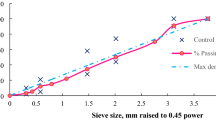Abstract
Flowable fill is a self-levelling and self-compacting, cementitious material which is primarily used as a backfill. It is a mixture of fine aggregates, small amount of cement, water and a by-product material. In this present experimental study, three industrial by-products namely fly ash, rice husk ash and quarry dust were used as constituent materials in flowable fill. Mix proportions were developed for different combination of these industrial by-products, in addition to small amount of cement content. The main objective of the present investigation is to study the stress–strain behaviour of these mixes, namely unconfined compressive strength (UCS), strain corresponding to peak stress, strain corresponding to fracture and modulus of elasticity. In addition, several mixes were tested for few other properties such as flowability, density, water-absorption and volume changes. The range of strengths, strains and moduli of elasticity obtained for these flowable fill mixtures represents different types of clay soils ranging from soft clays to very stiff clays. Thus, industrial by-products such as fly ash, rice husk ash and quarry dust can be beneficially added in flowable fill that offers comparable strengths to soils used for conventional fills and many other low-strength applications.













Similar content being viewed by others
References
ACI Committee 229 (1999) Controlled low-strength materials (CLSM) (ACI 229R-99). American Concrete Institute, Farmington Hills
ASTM D 6103-97 (2002) Standard test method for flow consistency of controlled low strength material (CLSM). Annual Book of ASTM Standards. Soil and Rock West, Conshohocken
Butalia TS, Wolfe WE, Lee JW (2001) Evaluation of a dry FGD material as a flowable fill. Fuel 80:845–850. doi:10.1016/S0016-2361(00)00159-9
Dingrando JS, Edil TB, Benson CH (2004) Beneficial reuse of foundry sands in controlled low strength material. J ASTM Int 1(6). doi:10.1520/JAI11869
Duncan JM, Buchignani AL (1973) Failure of underwater slope in San Fransisco bay. J Soil Mech Found Div 99(SM9):687–703
IS 8112-1989 (1989) Specification for 43 grade ordinary Portland cement. BIS, New Delhi
IS 2386-1963 (1982) Methods of tests for aggregates for concrete. BIS, New Delhi
IS 383-1970 (1970) Specification for coarse and fine aggregates from natural sources for concrete. BIS, New Delhi
Katz A, Kovler K (2004) Utilization of industrial by-products for the production of controlled low strength materials (CLSM). Waste Manag 24:501–512. doi:10.1016/S0956-053X(03)00134-X
Nagaraj TS, Udayshankar BC, Shashishankar A (2006) Flow behaviour of CLSM slurries—analysis and assessment. Bull ACCE (I) 2006(1):39–44
Nmai CK, McNeal F, Martin D (1997) New foaming agent for CLSM applications. Concr Int 19(4):44–47
Pierce CE, Blackwell MC (2003) Potential of scrap tire rubber as lightweight aggregate in flowable fill. Waste Manag 23:197–208. doi:10.1016/S0956-053X(02)00160-5
Pierce CE, Tripathi H, Brown TW (2003) Cement kiln dust in controlled low strength materials. ACI Mater J 100(6):455–462
Taha R, Al-Rawas A, Al-Jabri K, Al-Harthy A, Hassan H, Al-Oraimi S (2004) An overview of waste materials recycling in the sultanate of Oman. Resour Conserv Recycling 41:293–306. doi:10.1016/j.resconrec.2003.10.005
Tikalsky P, Smith E, Regan R (1998) Proportioning spent casting sand in controlled low strength materials. ACI Mater J 95(6):740–746
Tikalsky P, Gaffney M, Regan R (2000) Properties of controlled low strength material containing foundry sand. ACI Mater J 97(6):698–702
Author information
Authors and Affiliations
Corresponding author
Rights and permissions
About this article
Cite this article
Nataraja, M.C., Nalanda, Y. Stress–Strain Behaviour of Flowable Fill. Geotech Geol Eng 27, 341–354 (2009). https://doi.org/10.1007/s10706-008-9233-0
Received:
Accepted:
Published:
Issue Date:
DOI: https://doi.org/10.1007/s10706-008-9233-0




